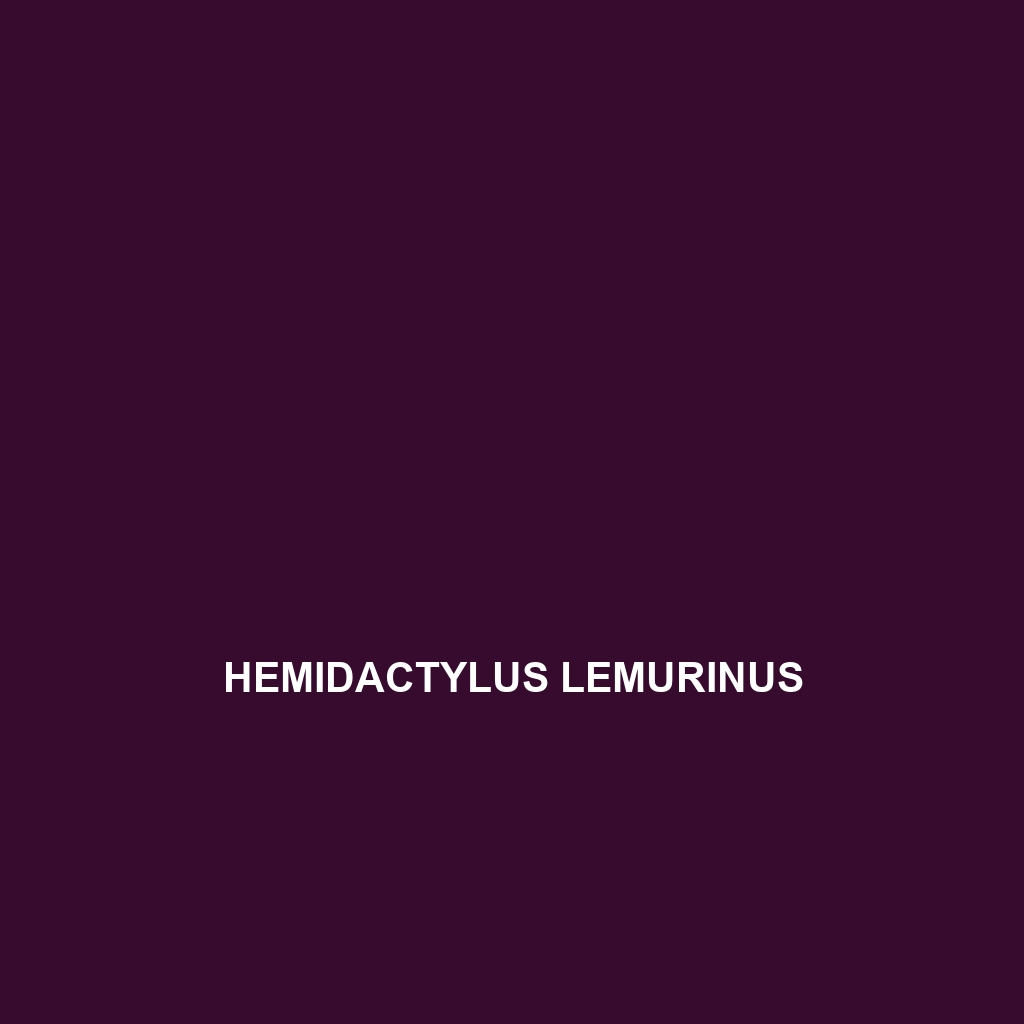Common Name
Hemidactylus lemurinus
Scientific Name
Hemidactylus lemurinus
Habitat
Hemidactylus lemurinus, commonly known as the Madagascar House Gecko, is primarily found in Madagascar, particularly in the northeastern regions of the island. This species thrives in diverse habitats, which include tropical rainforests, subtropical dry forests, and savannas. The humid climate and dense vegetation of rainforests provide an ideal setting for these geckos, as they offer abundant hiding places and food sources. In addition, they can also be found in human-influenced environments, such as rural houses and gardens, illustrating their adaptability to various living conditions.
Physical Characteristics
With a body length of approximately 8 to 12 centimeters, Hemidactylus lemurinus exhibits a slender and elongated shape characteristic of many gecko species. Its coloration is one of its most distinguishing features; typically, it showcases a mottled pattern in shades of brown and gray, which aids in camouflage against tree trunks and rocky surfaces. The gecko possesses large, bulging eyes that provide excellent night vision, enabling it to be a proficient nocturnal hunter. A notable adaptation is its specialized toe pads, which allow it to climb effortlessly on various surfaces, making it a proficient arboreal navigator.
Behavior
Hemidactylus lemurinus is primarily nocturnal, emerging at night to hunt for food and engage in social interactions. During the day, these geckos retreat to shelters such as tree bark, leaf litter, or crevices to avoid predators. Their nocturnal behavior includes unique mating rituals, during which males often engage in vocalizations and displays to attract females. Additionally, these geckos exhibit territorial behaviors, where dominant males may establish and defend specific areas from other males. Their social interactions can also be observed during feeding when they forage alone or in small groups, showcasing a mixture of solitary and communal behavior.
Diet
Hemidactylus lemurinus is primarily insectivorous, with a diet that includes a variety of insects, such as beetles, crickets, and moths. They actively hunt during the night, employing their acute vision and agility to catch prey. While they primarily consume insects, these geckos are also known to consume other small invertebrates, making them opportunistic feeders. Their predatory role helps maintain the balance of insect populations in their habitats, contributing to the ecosystem’s overall health.
Reproduction
The reproductive cycle of Hemidactylus lemurinus typically commences during the warmer months, coinciding with the onset of the rainy season, which provides optimal conditions for breeding. Mating occurs after elaborate courtship displays, with males performing various signals to attract females. After successful mating, females lay clutches of one or two eggs, usually in hidden locations such as under leaf litter or within crevices to protect them from predators. The incubation period lasts approximately 30 to 60 days, after which hatchlings emerge fully developed. They are independent at birth and receive no parental care, highlighting the species’ strategy to enhance survival rates through camouflaged nesting.
Conservation Status
Currently, Hemidactylus lemurinus is classified as Least Concern on the IUCN Red List. However, it faces potential threats from habitat destruction due to deforestation, agricultural expansion, and urbanization. Although significant populations still exist in protected areas, ongoing conservation efforts are crucial to monitor their status and mitigate potential impacts from environmental changes. Preservation of Madagascar’s unique ecosystems is essential, as they play a vital role in maintaining biodiversity.
Interesting Facts
One intriguing aspect of Hemidactylus lemurinus is its ability to regenerate its tail after losing it, a common defense mechanism among geckos. This adaptation allows them to evade predators while still surviving and thriving in their natural habitats. Additionally, the Madagascar House Gecko’s vocalizations are quite unique compared to other gecko species, providing insights into their social interactions and territorial behaviors. These geckos can also exhibit a range of colors and patterns, further enhancing their camouflage capabilities.
Role in Ecosystem
Hemidactylus lemurinus plays a crucial role in its ecosystem, serving as both predator and prey. As a predator, it helps control insect populations, which can prevent outbreaks of pest species in its habitat. These geckos are also a source of food for larger predators, including birds and small mammals. Their presence contributes to a balanced food web, illustrating their importance in maintaining ecological stability. Furthermore, geckos like Hemidactylus lemurinus can act as indicators of environmental health, as changes in their populations can signal shifts in ecosystem dynamics.
